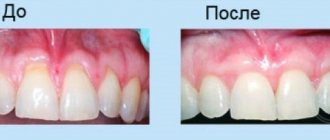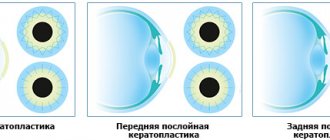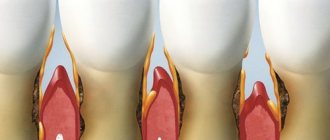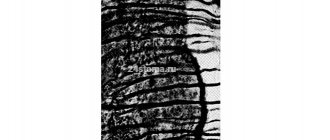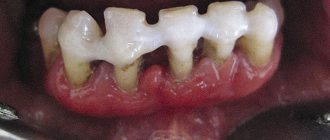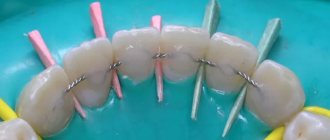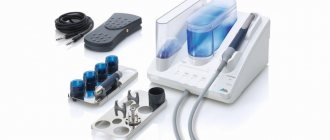Indications
The main indication for installing a clasp denture with a splinting effect is the absence of several teeth in the presence of loose or unstable areas in the jaw structure. The cause of the development of pathologies can be either maxillofacial trauma or degenerative-inflammatory processes in the oral cavity. The second option is the most common. Thus, periodontal damage with receding gums and exposure of the roots leads to loosening of the teeth, while a splinting prosthesis reliably fixes the crowns and does not put pressure on the soft tissues, allowing them to recover. This increases the effectiveness of complex treatment of periodontal disease and periodontitis.
Thus, splinting clasp dentures simultaneously solve several dental problems:
- stabilize mobile teeth in the correct position;
- competently redistribute the chewing load on the gums;
- restore the integrity of the row and the aesthetics of the smile line.
On a note!
Periodontium is a complex of tissues located around the tooth. It includes the gums, alveolar walls, ligaments, and bone tissue. When these structures are destroyed, the tooth root gradually loses support and the tooth begins to wobble.
Contraindications to the installation of splinting clasp dentures:
- Extreme degree of periodontal destruction with a high risk of tooth loss. In this case, it is difficult to take impressions without causing loss.
- The patient’s inability to maintain healthy oral hygiene – when wearing dentures, bacterial plaque accumulates especially actively around the crowns, provoking the carious process.
- Complete absence of teeth (complete edentia) - installation of clasp structures requires the presence of at least one supporting tooth.
- An allergic reaction to anesthesia or materials of construction - metal alloys, plastics, acrylic compounds may cause irritation or discomfort in some patients.
Indications for installation
Installation of the prosthesis.
Dental splinting is mainly used to correct the following problems:
- the absence of three units in a row in the dentition, while one of the sides does not have an abutment tooth;
- incorrect position of teeth;
- absence of one unit in the dentition;
- bleeding gums;
- displacement of teeth with exposure of roots;
- the presence of gum pockets and signs of periodontal disease;
- bruxism, deep bite;
- other dental anomalies.
The primary task in diagnosing periodontal diseases is the installation of a bridge process in order to evenly redistribute the load on the supporting teeth. The progression of periodontitis provokes the loosening of units, which requires urgent measures to prevent their loss.
The clasp design firmly holds the teeth in the correct direction with the help of special fasteners and a metal arch.
Peculiarities
The German word “byugel” is translated as “arc,” which reflects the main feature of the design: artificial crowns are attached to a curved base made of medical alloy. When put on, the denture fits tightly to the gum due to metal fasteners, which provide reliable fixation without the risk of losing the false jaw. Moreover, in order to remove the prosthesis on your own, you will have to make considerable efforts.
Unlike plate-based removable “brothers”, the prosthesis turns out to be more convenient: the base for the lower jaw is not so massive, and the upper structure is devoid of an inconvenient solid plate that completely covers the palate - it is replaced by a thin bridge that does not create inconvenience during operation. In addition, the clasps and the base itself do not compress the teeth from the sides, which allows complex treatment of periodontal tissues to be carried out without interference.
Types of fastenings for splinting prostheses:
- multi-link clasps (the most common method of fixation);
- occlusal pads;
- claw clamps.
All of them reliably fasten the teeth together, eliminating their mobility, and at the same time contribute to better redistribution of the load along the gingival arch, do not irritate the tissue and prevent gum atrophy.
Pros and cons of splinting clasp devices
In order for the prosthetic system to solve all the assigned dental problems, it is selected taking into account the condition of the remaining units, the degree of their loosening, location features, and the quality of the periodontium as a whole. If a clasp-type splinting prosthesis is selected and installed correctly, it ensures the most even distribution of the chewing load on the remaining abutment teeth.
Its other advantages include:
- compact size, making it easier for the patient to get used to the presence of a foreign body in the mouth;
- the absence of an artificial palate that spoils diction;
- sufficient strength and durability;
- creating conditions in the oral cavity that make it possible to inhibit further atrophy of bone tissue.
Among the disadvantages of clasp splinting devices:
- Lack of aesthetics. That is why young people rarely resort to their help.
- Gradual weakening of the splinting effect.
- Risk of injury to the mucous membranes of the oral cavity with metal clasps when putting on the device.
Stages of prosthetics
At the preparation stage, the patient undergoes an X-ray examination. They evaluate the condition of hard and soft tissues, the structure of the bite, the functioning of the jaw joints, the presence of inflammation, the percentage of destruction of individual structures, and check the general condition of the oral cavity. Immediately before the start of orthopedic treatment, foci of caries are eliminated, professional cleaning is carried out to remove soft and hard deposits in the neck and root area, and curettage is performed if necessary.
Attention!
In the case of high tooth mobility, periodontal pockets are cleaned after the installation of dentures - in order to avoid even further loosening.
The production and installation of splinting clasp dentures takes place in 4 stages:
- Taking impressions – in the classical way using plastic materials or using digital technologies of 3D scanning of the oral cavity. If there is a high degree of tooth mobility, the second option is preferable - it eliminates the possibility of a mobile tooth falling out.
- Creation of a prosthesis - using impressions in a dental laboratory, a copy of the patient’s jaw row is made, on the basis of which the technician forms the base and coronal part of the working structure.
- Fitting and modification - the finished prosthesis is tried on and, if necessary, adjusted, eliminating inconsistencies.
- Final installation is performed by an orthopedic dentist after all roughness of the product has been eliminated.
During operation, the patient can independently remove and install the structure. However, this should not be done unless absolutely necessary - frequent pressure on the tight fastening of the prosthesis can aggravate the mobility of loose crowns. The prosthesis is removed once every 2–3 weeks for preventative cleaning. The rest of the time, hygienic care of the device is carried out directly in the oral cavity with a special brush and paste.
On a note!
In addition to convenient removable structures, there are non-removable medical devices that can be installed and removed only in a dental office. As a rule, they are used for temporary course treatment.
Features of care
Fastening of the clasp prosthesis (attachment).
Caring for clasp dentures involves performing the same measures as for other types of structures.
Basic rules of care include:
- for hygiene procedures (2 times a day), use a non-abrasive paste and a brush with medium-hard bristles;
- After each meal, use a mouthwash to remove small particles of food;
- clean dentures with a special solution once a day;
- undergo a preventive examination with a dentist at least once every six months in order to identify problems early;
- review your diet, reducing the consumption of sweets, soda, foods with a solid structure, the same applies to sticky and viscous foods.
Compliance with simple requirements extends the life of prosthetic structures, reduces the risk of developing dental diseases, and, importantly, minimizes the risk of prosthetic breakage.
Advantages
Positive aspects of clasp dentures:
- strong fixation – among removable structures they are the most reliable;
- convenient configuration – provide a more uniform distribution of the load on the soft tissue of the gums due to the presence of supporting teeth;
- comfortable to wear - a relatively small base does not cover the palate, does not distort taste, does not impair diction and does not rub soft tissues;
- possibility of installation without grinding healthy teeth;
- long service life - with proper care it can last up to 10 years.
On a note!
A clasp prosthesis, as well as its plate analogue, can lead to gradual atrophy of bone tissue, however, due to optimal redistribution of the load, it develops 2–3 times slower than with any other types of removable structures
.
Clasp prosthesis on telescopic crowns.
The telescopic fixation system is used for low clinical crowns of natural teeth and poorly defined tooth shapes. The system consists of two parts: a metal cap (inner part) - which covers the natural tooth and a crown, which is connected to the base of the prosthesis (outer part).
When fixing the prosthesis, both parts form a connection, the separation of which is possible only when it is moved vertically.
Advantages: higher aesthetics compared to clasp dentures; improved fixation.
Disadvantage: the need to prepare your own teeth.
Dental laboratory Denta-MDS - a full range of services for the manufacture of dentures
If you want to prevent tooth loss or restore their row, then in Moscow, contact our specialized dental laboratory Denta-MDS. We specialize in the production of clasp splinting prostheses, guaranteeing our clients the following advantages:
- affordable price;
- high quality, thanks to modern consumables and equipment;
- individual approach to the client;
- convenient work schedule.
You can find out what the prices are for clasp splinting prostheses by calling 8-495-649-97-97. Also here you can sign up for an initial consultation, during which the final cost will be determined and a treatment plan will be outlined.
| Splinting clasp prosthesis | Price | Deadlines |
| Splinting clasp prosthesis | 16600 | 7 |
Manufacturing
To install a denture, you need to visit the dentist several times. At the first stage, the doctor examines the patient and determines what dental pathologies he has. Based on the information received, he creates a clear and effective treatment plan. Takes necessary measurements, prepares supporting elements.
The second stage is making the impression tray. The client is asked to come in for impressions to be taken, which are sent to the dental laboratory. Based on them, a model is made from wax and plaster, and a base with a frame for crowns is cast.
The next stage is the first fitting of the prosthesis. During this process, detected inaccuracies are eliminated. Only after this is the wax arc replaced with a plastic analogue, and the base is ground and polished.
On the appointed day, the clasp splinting device is installed on the patient and adjusted. The installation procedure is quite simple and takes very little time. The doctor tells the client in detail how to properly remove and put on the mechanism independently, and how to care for it.
